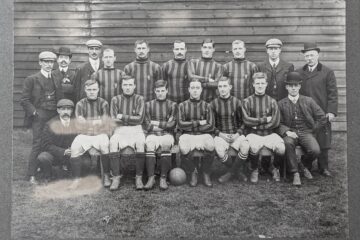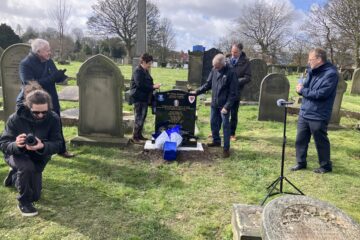Due to the disruption that followed World War One, Tommy Mayson slipped unnoticed by the local press into the ranks of Everton Football Club in June 1919. He was born 8 December 1886 at Whitehaven in Cumberland and was the second child of John, a plasterer, and his Irish-born wife, Sarah.

The 1891 census (above) found the family living in the Northumberland village of Mickley, but by 1901 they had settled in the Byker area of Newcastle-upon-Tyne. Young Tommy began his football career with Walker Parish Church – who were members of the Northern Alliance League – where his skilful inside-forward play earned him the moniker of ‘The Walker Wonder’. This alerted the area scout of Football League side Burnley who gained his signature during the summer of 1907.

He spent four seasons with the Division Two outfit, playing around sixty-seven matches, before signing for a Grimsby Town side who had just been re-elected to the Football League. Mayson remained with The Mariners until the Football League was suspended due to the conflict in Europe, and returned to Tyneside where he was reported to be engaged with war work for the government. While there, he accepted an invitation to play ‘wartime football’ with Leeds City before joining Everton – from Grimsby Town – for a fee of around £300. He took part in the pre-season practice game and was selected to represent the Second XI in their match at Nelson. However, at the eleventh hour, he was told he would be playing for the senior side in the opening game of season against Chelsea at Goodison Park. This was due to the fact that Joe Clennell, the first choice inside-left, had moved to live in Blackpool without informing the executive, and was temporarily suspended.
The visit of the Londoners attracted a crowd of around 30,000 spectators who were anxious to witness the return of professional football in England. They saw Alan Grenyer put Everton ahead, but the visitors hit back to lead 2-1 at the interval. Despite Mayson’s headed equaliser for the home side, Chelsea took both points with a late goal scored by Hulse. Mayson then took his place in the reserve pool of players but was not retained when the season came to an end. He moved to South Wales where he joined a Pontypridd side who had just turned professional and become members of Southern League.
During his time at Taff Vale Park he met and married local girl Cissie John, and took part in the Welsh FA Cup Final but his side were beaten, after replay, 3-0 by Wrexham. Mayson spent a season with Wolverhampton Wanderers, where he made two appearances, before accepting the offer to become player-manager of Aberdare Athletic in June 1922. The Welsh side – who were members of Football League Division Three South – finished the season near the foot of table but did reach the final of Welsh FA Cup. They were beaten 3-2 by Cardiff City. He then ended his playing career with Pontypridd before being appointed to the coaching staff at Queens Park Rangers where he remained for several seasons. Thomas Mayson later joined the training staff at Middlesbrough and was still resident there at the time of the 1939 census shown below.




